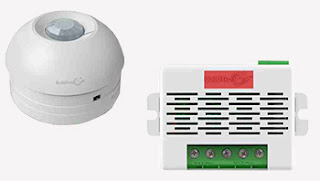Occupancy Sensors

Occupancy sensors for lighting control typically use infrared (IR), ultrasonic, tomographic motion detection, microwave sensors, or camera-based sensors (image processing). The field of view of the sensor must be carefully selected/adjusted so that it responds only to motion in the space served by the controlled lighting. For example, an occupancy sensor controlling lights in an office should not detect motion in the corridor outside the office. Tomographic motion detection systems have the unique benefit of detecting motion through walls and obstructions, yet do not trigger as easily from motion on the outside of the detection area like traditional microwave sensors . Sensors and their placement are never perfect, therefore most systems incorporate a delay time before switching. This delay time is often user-selectable, but a typical default value is 15 minutes. This means that the sensor must detect no motion for the entire delay time before the lights are switched. Most...